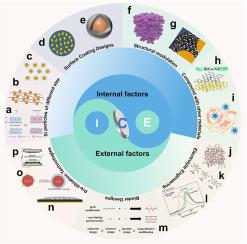Strategies for enhancing the initial coulombic efficiency of Si-based anodes in lithium-ion batteries
IF 11.6
2区 材料科学
Q1 CHEMISTRY, PHYSICAL
引用次数: 0
Abstract
Si-based anodes are considered a pivotal material for next-generation high-energy-density lithium-ion batteries (LIBs) due to their significantly higher theoretical specific capacity compared to conventional carbon-based anodes. However, the low initial coulombic efficiency (ICE) of Si-based anodes leads to continuous lithium consumption, triggering severe cascading reactions and significantly compromising cycling stability, thereby hindering their practical implementation. To promote the development of Si-based anodes, researchers have extensively investigated the underlying the mechanisms of low ICE and proposed effective strategies to mitigate this issue. This review synthesizes the recent research progress, elucidates the fundamental causes of low ICE in Si-based anodes, and systematically summarizes various strategies to enhance ICE. It provides valuable insights for the rational design and preparation for high ICE Si-based anodes and lays a foundation for their industrial application as next-generation high-electron/ion-throughput LIBs anodes.

提高锂离子电池硅基阳极初始库仑效率的策略
硅基阳极被认为是下一代高能量密度锂离子电池(lib)的关键材料,因为与传统的碳基阳极相比,硅基阳极具有更高的理论比容量。然而,硅基阳极的低初始库仑效率(ICE)导致锂的持续消耗,引发严重的级联反应,严重影响循环稳定性,从而阻碍了其实际应用。为了促进硅基阳极的发展,研究人员广泛研究了低ICE的潜在机制,并提出了有效的策略来缓解这一问题。本文综述了近年来的研究进展,阐述了硅基阳极低ICE的根本原因,并系统总结了提高ICE的各种策略。这为高ICE硅基阳极的合理设计和制备提供了有价值的见解,并为其作为下一代高电子/离子通量lib阳极的工业应用奠定了基础。
本文章由计算机程序翻译,如有差异,请以英文原文为准。
求助全文
约1分钟内获得全文
求助全文
来源期刊

Carbon
工程技术-材料科学:综合
CiteScore
20.80
自引率
7.30%
发文量
0
审稿时长
23 days
期刊介绍:
The journal Carbon is an international multidisciplinary forum for communicating scientific advances in the field of carbon materials. It reports new findings related to the formation, structure, properties, behaviors, and technological applications of carbons. Carbons are a broad class of ordered or disordered solid phases composed primarily of elemental carbon, including but not limited to carbon black, carbon fibers and filaments, carbon nanotubes, diamond and diamond-like carbon, fullerenes, glassy carbon, graphite, graphene, graphene-oxide, porous carbons, pyrolytic carbon, and other sp2 and non-sp2 hybridized carbon systems. Carbon is the companion title to the open access journal Carbon Trends. Relevant application areas for carbon materials include biology and medicine, catalysis, electronic, optoelectronic, spintronic, high-frequency, and photonic devices, energy storage and conversion systems, environmental applications and water treatment, smart materials and systems, and structural and thermal applications.
 求助内容:
求助内容: 应助结果提醒方式:
应助结果提醒方式:


